How to clean the drum in a washing machine: sequence of actions
A washing machine, like any other type of household appliance, needs proper care.As a result of operation, grease settles on the unit drum and other working parts, mineral deposits and persistent dirt appear.
They will certainly lead to increased load and subsequent breakdown. Regularly cleaning the drum in a washing machine will significantly increase the service life of the equipment. Let's figure out how to properly clean the drum.
The content of the article:
Regular cleaning is excellent prevention
Without the slightest doubt, a washing machine is considered an essential component of a furnished home. It’s hard to imagine that anyone now could do without this “tireless home assistant.” Diligently dealing with our problems, the machine interacts with detergents, technical and edible oils, and poorly filtered tap water.
In terms of dirt deposition, the most vulnerable component of the unit is the drum, which is in direct contact with both the laundry being washed and with powders, conditioners and similar liquid products. Unfortunately, most housewives judge whether the drum is dirty only by the appearance of an unpleasant odor, reminiscent of the “aromas” of a swamp.
In fact, smell is not the most insidious enemy of washing equipment, although it should be given the utmost attention. It signals the appearance of putrefactive bacteria and mold fungi, causing harm to the things processed by the machine, and not to the working units and parts.
Note that the atmosphere formed by microorganisms creates an extremely serious threat to the health of the owners of the premises with a washing machine. This means that it should be fought with a zeal worthy of its significance.
The danger to the functional parts of washing units lies in mineral deposits. This scale settles both on the surface of the drum accessible to users and on its back side. If the first component can be easily dealt with using folk remedies, then eliminating the second often requires disassembling the machine with removing the tank with the drum.
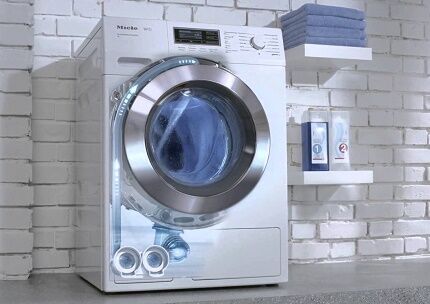
The list of problems caused by scale includes:
- Disruption of water circulation during washing. The perforation of the drum clogged with sediment prevents the normal flow and outflow of water.
- Failed drain pump. “Pushing” water through a filter clogged with scale, the pump experiences almost cosmic loads and eventually breaks down.
- Slow down water heating. The thermal conductivity of the mineral deposit is noticeably lower than that of the metal parts of the machine without it. Mineral deposits as a result affect the quality of washing.
- Increased energy consumption. Units and systems operating under load consume more electricity.
- Accelerated wear of the tank and drum pulley. Mineral sediment contributes to abrasion of contacting and closely located elements.
Scale appears due to the supply of water to the machine with an impressive content of magnesium and calcium salts. Installing main filters will help eliminate or significantly reduce the flow. However, they will not be able to completely eliminate the likelihood of sediment formation. Those. You will still have to clean the unit, although much less frequently.
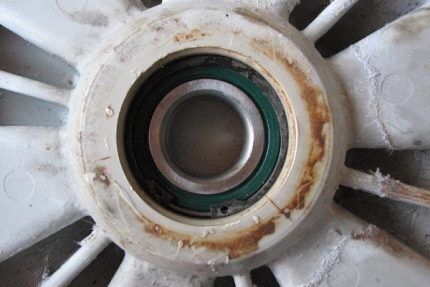
Rust, of course, is a dangerous factor for washing machines, but it is mainly the body that suffers from it. Drums are made from materials adapted to work in water with household chemicals. Although this does not mean that cheap units are not susceptible to rust.
In order to eliminate all possible preconditions for reducing the service life of the machine and conditions that threaten the health of the owners, regular, competent care is necessary. The peculiarities of its implementation should be understood.
Methods for caring for the washing machine drum
It has already been found out that it is scale that causes the most damage to the drum, and bacteria and fungi to the user’s health. It is clear that to declare war, microorganisms need disinfectants, and to remove mineral deposits, substances capable of dissolving it are required.
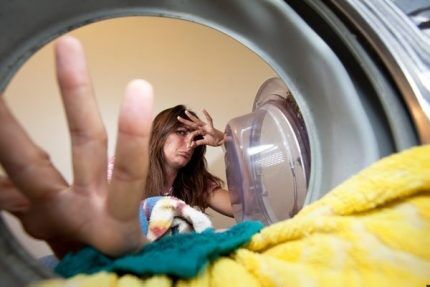
The principle of cleaning the drum in both situations is to treat its surface, for which machine owners have two methods at their disposal, these are:
- Using the cleaning mode. Can only be used in units with the specified function, for example, in LG equipment with an ECO cleaning mode.
- Apply and wash off the composition with an action appropriate to the problem. It is used in automatic and semi-automatic machines without the above function.
Both methods involve carrying out a kind of “washing”, but without loading laundry. In the first case, the equipment simply “rinses” the drum and other components with hot water; in the second, the unit is turned on to simply rinse off the substance previously applied to the drum.
Using the Auto Clean function
Happy owners of machines with a drum cleaning mode do not need to spend personal time on, frankly speaking, difficult maintenance. Their equipment is independently freed from greasy deposits, detergent residues, grains of sand and small organic matter. Everything that the unit could not cope with during the washing period is dissolved and removed.
Cleaning is carried out in three standard stages:
- The normal pre-mode is activated.
- The cleaning function is activated, carried out at 90 ° C and at a speed of 150 rpm. There are washing machines on the market that perform similar work at 50 - 60 °C.
- A double rinse with spin starts at maximum speed.
Before washing the washing machine drum, be sure to clean the filterso that nothing interferes with the drainage of water. Please note that the described procedure does not eliminate mineral deposits. In order to get rid of scale, a bag of “Antin-scale” or citric acid is poured into the receiving ditch of the machine before starting.
At the end of the program, the hatch of the machine should be opened or at least slightly opened at an angle that does not impede free movement around the bathroom or kitchen. The moisture remaining in the drum should completely evaporate, after which it should be wiped with a dry, “dust-free” cloth, i.e. leaving no fibers on the surface.
It should be remembered that double rinsing simply must completely remove all the product and the scale dissolved from it from the tank. If there is a suspicion that the substance used in cleaning has not all been washed away with water, the process should be repeated. Otherwise, during normal washing, the laundry will fade, fade, and then begin to wear out faster.
Unfortunately, not all washing units have this very useful mode described. If the owners of the equipment were unable to buy such a machine, the actions are carried out in a different order.
Application of traditional methods
Let's start with intimidation and listing the horrors that threaten the use of overly active products to clean the drum.
The results of using unnecessarily caustic substances include:
- Softening and deterioration of seals. In particular, deformation of the rubber cuff of the laundry loading hatch, requiring immediate replacements.
- Damage to the metal surface of the drum. The appearance of roughness and even burrs will cause the clothing to lose its appearance.
- Changes in the shape and size of plastic parts, as a result, the formation of backlash and weakening of connections.
- Jamming of the moving elements of the machine due to a large piece of undissolved scale getting into the gap between them.
- Clogged drain system filter and subsequent pump failure.
In addition, if strong chemicals are not completely removed from the surfaces of the drum, they will end up in the wash water. Linen that has absorbed a caustic substance will cause allergies, and it is possible that a chemical burn will occur.
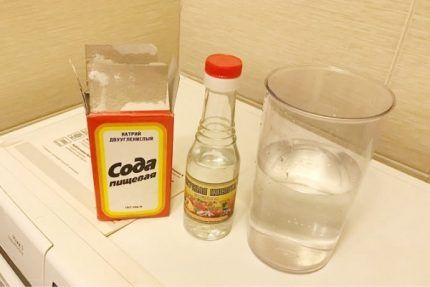
Taking into account the above circumstances, the use of “folk recipes”, especially their dosage, should be treated with extreme caution.
We remember that to remove mineral deposits we need to dissolve it or at least soften it. This is easy to do without a technician, without disassembling the unit into its component parts and without removing the drum out.To do this, from quite accessible and really inexpensive ingredients, you will have to prepare a composition that corrodes the sediment, but does not affect the working parts of the unit.
Any housewife can find the starting material for the cleaning mixture in her own beloved kitchen. To combat magnesium and calcium salts, you only need ordinary table vinegar, equally unremarkable citric acid and soda. They fit perfectly and cost just pennies.
Method No. 1 - soda and vinegar against scale
To mix in the required proportions, we will stock up on a plastic cup with a volume of 50 - 100 g and a sponge. If you don’t have ready-made nine percent vinegar at home, you need to make it by dissolving one part of the essence in seven parts of water.
To clean the drum we will proceed in the order below:
- Measure out 1/4 plastic cup of baking soda and exactly the same volume of water, mix them until the powder is completely dissolved.
- Pour this cool soda solution into the machine box designed for loading detergents.
- Take 2 portions of nine percent vinegar indicated by a glass and pour them into the drum.
We close the hatch as expected, open the tap that shuts off the flow of water into the supply hose from the water supply. On the control panel we set the temperature to 60 - 70 °C and start the washing “session”. Upon completion of cleaning, clean the drain system filter, leave the unit with the hatch open to dry, then wipe it dry.
Method No. 2 - citric acid
The next method is much simpler. It generally requires only citric acid, the volume of which is selected according to the volume of the machine’s tank. You will need from 1 to 6 standard packs.
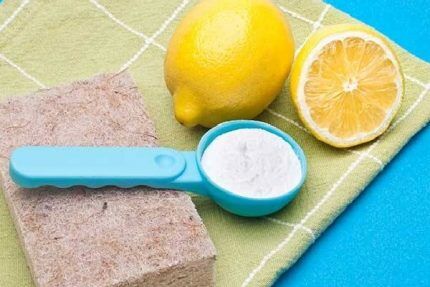
To clean the machine drum, do the following:
- Dilute the powdered lemon juice with water in equal parts.
- Pour the solution into the detergent box.
- Let's start the longest wash cycle.
During cleaning using this method, you must select the maximum temperature. Further actions are no different from the steps described above.
Detailed instructions for cleaning a washing machine using citric acid can be found in this material.
Method No. 3 - cleaning with baking soda powder
You will need a sponge with a hard pad on one side and a pack of soda; its actual consumption is determined as the cleaning progresses. There is no need to prepare a solution from soda.
To clean the drum, follow these steps:
- Pour baking soda onto the hard pad of the sponge and carefully wipe off the dirt.
- As the soda is consumed, add it to the sponge. In case of a weak reaction between soda and scale, lightly moisten the sponge.
- Leave the drum completely alone for half an hour until the calcium build-up softens.
- We activate the wash by setting the temperature to 70 - 90 °C.
- Set the double rinse mode on the control panel.
If, after rinsing, you feel that the drum is poorly rinsed from soda, the machine will have to be started again. However, it will be necessary to maintain the time interval specified by the manufacturer between two washing sessions occurring one after another.
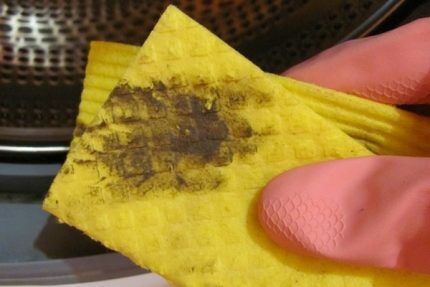
In addition to folk wisdom and the compositions it proposes, household chemicals are used in cleaning work, purposefully produced to solve designated problems.
The packaging with the product traditionally provides detailed instructions on its use and dosage recommendations.
Valuable tips for caring for your machine
You should not get carried away with harsh measures in caring for the washing machine drum; it is better not to bring the equipment to such a sad state.
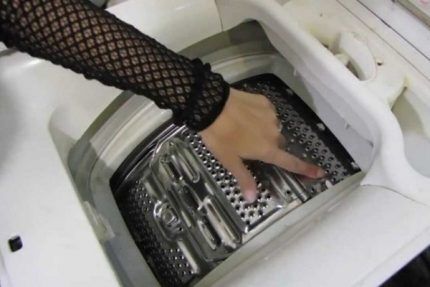
To prevent the formation of mineral deposits on the drum walls, you must:
- Use antiscale for washing machines. The data sheets of automatic and semi-automatic devices indicate the frequency of use of preparations such as Calgon. It depends on the formula of plastic and elastomers of specific models.
- Install the softener filter. Including mechanical and magnetic filtering devices in the water supply will prevent hard water from entering the tank of the machine.
- Wash preferably at 40 - 50 °C. During high-temperature washing, scale forms much more intensively than at low temperatures.
- Check the pockets of items loaded into the unit. Before washing, you need to carefully check the contents of the pockets so that objects that pose a risk of clogging do not get inside.
- Regularly “ventilate” the tank. It is necessary to allow the parts of the washing machine to dry.
- Avoid cleaning the unit with a direct jet of water. Prevent even drops from reaching the electronic control system.
- Maintain your machine regularly. To extend the operating life of the unit, regular maintenance is required. Manual steps only need to be carried out when the power supply is disconnected.
There is also no need to pour more powder into the box than is required to produce one wash. To combat unpleasant odors, it is permissible to use chlorine-containing household chemicals.
Conclusions and useful video on the topic
Care and prevention of washing machines with drum cleaning function:
Citric acid in caring for equipment:
Advice from the user on the prevention and cleaning of the washing machine:
Compliance with simple rules for operating the washing machine, prevention and reasonable use of cleaning products is a guarantee of service life exceeding the limits stated by the manufacturer.
How do you clean the drum in your washing machine? Share your own care methods with our readers - leave comments, share your experience, and ask questions in the block below.




I clean the washing machine periodically with citric acid. I spread it out, pour it into the powder compartment and turn on the program, but I don’t load laundry.There is a lot of information on the Internet on how to bleach laundry using acetylsalicylic acid. I am a doctor and often wash white coats. When washing them, I tried adding 10 crushed tablets of this same acetyl to the powder. I was pleased with the result. The robes are snow-white. I think this is also useful for the machine: acetylsalicylic acid helps soften water and remove scale.
It is better to use soda than citric acid. Citric acid in bags is no longer what it used to be. It’s not even sour, but somehow disgusting, completely incomprehensible. This means there will be no sense from it. I boiled a kettle with it - no use. I need to learn more about acetylsalicylic acid, I’ll try it. And not only wash the machine, but also wash clothes with it, if that’s the case.
Is there any effective chemistry that would definitely help? I tried aspirin and citric acid, but there was practically no result. And the second question: is it difficult to clean the machine manually?
Hello. Manually - does it involve disassembling the tank? Such work is best carried out by specialists. It is worth making some efforts to prevent and reduce the risk of contamination.
In general, what causes a washing machine to become dirty? These are deposits of salts and minerals from the water, which can be solved by installing filters, as well as using specialized anti-scale products with each wash, for example, the once sensational “calgon”. Of course, not everyone can afford this, you can also use them for cleaning periodically, as there are many products for universal use, during washing and for single cleaning. FILTERO 601 is highly praised, its price is approximately 150 rubles per package.The downside is that it is an uneconomical use of funds. TOP HOUSE liquid, 37 applications for 450 rubles. In addition, Magic Power, Topper, Anti-scale, Bork (4 cleanings for 990 rubles, not the best offer), Luxus Professional are popular.
To prevent plaque, use powders with phosphonates (you can also use phosphates, but they are harmful to humans). True, they will not help with an already formed plaque, but they will prevent its appearance very well. It is recommended to pre-soak and rinse heavily soiled items before washing.
Folk remedies for cleaning are still the same acids, because magnesium-calcium salt (scale) is best dissolved by them. Choose any of the options:
1. Lemon 4-6 sachets at maximum temperature.
2. 1/4 cup of soda, 2 cups of vinegar, 1/4 cup of water - mix the soda with water, and pour the vinegar into the drum and turn it on at maximum speed.
If all else fails, it’s easier to invite a specialist.
Each time after washing, be sure to clean the rubber seals and clean the drain hole more often.